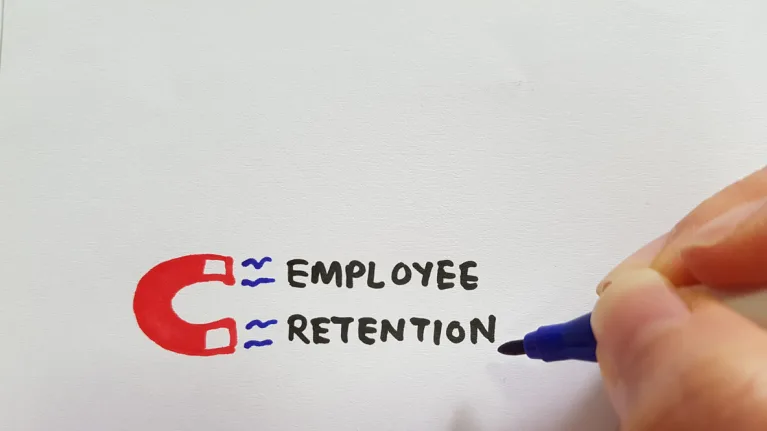Employee Retention Strategies
 Omer Usanmaz
·
10 minute read
Omer Usanmaz
·
10 minute read
Employee retention refers to the ability of a company to retain its employees over a long period. This is important for businesses because it helps ensure the workforce is stable and consistent, leading to increased productivity and efficiency. When remote employees need help and support to prevent burnout, we need to address how you can protect your employees from giving up and searching for opportunities outside when they can do the same within your organization. This blog will discuss various strategies companies can use for better employee retention. From offering competitive compensation packages to creating a positive work environment, we will explore the tactics that have proven effective in keeping employees engaged and committed to their jobs. This blog will provide valuable insights and helpful advice on improving employee retention within your organization. So, let's get started!
How Is Employee Retention Different from Employee Turnover?
Employee retention and employee turnover are two important concepts in HR systems that can take different meanings and imply different things for organizations. Employee retention refers to how an organization retains its employees over time. It measures how well the organization keeps its employees satisfied with their work and how well they prevent them from leaving the company for a competitor. Retention strategies include offering competitive compensation packages, providing high-growth opportunities, fostering an inclusive workplace culture, and addressing employee concerns and complaints promptly.
Employee turnover is the rate at which employees leave an organization, and the company hires new employees for those roles. It measures how often employees leave the company and is usually expressed as a percentage of total employees. High turnover rates can be costly for organizations, as they may require additional training expenses and lead to a loss of institutional knowledge and experience on in-house tools. While employee retention and turnover are closely related, they vary at a conceptual level. Retention strategies focus on keeping employees satisfied with their work, while turnover strategies focus on reducing the rate at which employees leave the organization. Organizations must consider retention and turnover when developing human resources strategies to retain top talent and minimize the cost of high turnover rates.
It's important to note that organizations should focus on why employees leave, understand the root causes, and take appropriate actions to address the issues rather than just focusing on numbers. Employee retention is both about keeping the employees and ensuring a healthy work-life balance exists for all employees in the organization.
What Part of the Company Culture Hinders the Employee Experience?
Company culture plays an influential role in shaping the employee experience. A supportive culture can foster employee motivation, and job satisfaction, while a toxic culture can have the opposite effect. Remember the following points when you're building a strong culture around your organization:
- A company culture that can hinder the employee experience is a lack of transparency and communication. When employees feel that they are not being kept informed about important decisions or changes within the organization, they may feel disengaged and disconnected from the company. This can lead to mistrust toward management.
- The company culture that can hinder the employee experience is a lack of inclusivity and diversity. When employees feel they do not belong or are not valued within the organization, they may experience feelings of isolation and marginalization. This can lead to a lack of engagement, motivation, and job satisfaction among employees from diverse backgrounds.
- An overly rigid and inflexible work environment can hinder the employee experience. When employees feel that they do not have the autonomy or flexibility to manage their work, they may feel demotivated, which leads to a lack of innovation and creativity within the organization.
- A lack of appreciation for employee contributions can also hinder the employee experience. When employees feel that their efforts are not being acknowledged or valued, it can lead to a lack of commitment and loyalty toward the organization.
Organizations need to recognize how important the company culture's role is in shaping the employee experience. By creating an inclusive and supportive culture, organizations can foster job satisfaction among employees. Organizations should be aware of the negative aspects of the company culture that can hinder the employee experience, such as a lack of transparency and key employee feedback that causes a lack of recognition and take appropriate actions to address them.
What Are the Various Employee Retention Strategies?
Companies use several employee retention strategies to keep employees committed to their jobs, while they also understand the difference between someone who is committed and someone who is just there to function and clock in the hours. Employees who are committed to their work tend to be more productive and boost the company's retention rates. Some of the most effective strategies include:
Onboarding and Orientation
The onboarding process and orientation are essential employee retention strategies. Onboarding is integrating new employees into the company, and orientation is introducing new employees to the company's culture, and policies.
Effective onboarding and orientation programs must include the following:
- A comprehensive orientation program including all aspects of the company's culture, policies, and procedures.
- A mentoring or buddy program that pairs new employees with experienced colleagues who can offer guidance and support.
- A training program that provides new employees with the skills and knowledge that would help them excel at their roles.
- Regular check-ins and follow-ups with new employees to ensure that they are adjusting well and to address any concerns that may arise.
- Assign a point of contact or HR representative available to answer any questions or concerns the new employee may have.
When employees feel informed and supported during the onboarding and orientation process, they are more likely to hit the ground running and feel like they are pushing the business for the growth goals you have.
Herzberg's Two-Factor Theory
Herzberg's Two-Factor Theory is a widely recognized motivational theory that can be applied as an employee retention strategy. According to the theory, two factors influence employee motivation and satisfaction: "hygiene factors" and "motivational factors." Hygiene factors are the basic necessities that must be met for employees to be satisfied in their jobs, such as fair compensation, good working conditions, and job security. These are considered "maintenance" factors, as they help prevent dissatisfaction but do not always bring out motivation and engagement. Motivational factors are the elements that inspire and drive employees to achieve their goals and perform to their best abilities. These include the larger picture and the opportunities for growth and advancement, meaningful work, and the ability to make a difference. When motivational factors are present, employees are more likely to be engaged and motivated, which boosts employee retention rates.
Understanding Herzberg's Two-Factor Theory is key in identifying which factors are important to employees; companies can create an environment that addresses both their basic needs and their desire for growth and development. For example, companies can ensure that their employees receive decent compensation, good working conditions, and job security. Provide chances for professional development and contribute to decision-making processes. By addressing both hygiene and motivational factors, companies can create a work environment that fosters employee well-being and retention.
Invest in Employees' Careers
Investing in employees' careers is an effective employee retention strategy. When employees feel that they're growing and their employer supports the growth, they are more likely to have the motivation and feel committed to their work. By providing employees with opportunities for professional development and career growth, companies can show that they value and invest in their current employees, which can help to foster a sense of loyalty and a good level of commitment.
There are several ways that companies can invest in their employees' careers:
- Providing training and development programs: Companies can offer various training and development programs, such as workshops, seminars, and online courses, to help employees acquire new skills and knowledge. This helps prepare employees for new roles.
- Offering mentoring and coaching: Companies can provide employees with mentoring and coaching opportunities to help them learn from more experienced colleagues and develop the skills and knowledge they need to advance in their careers.
- Providing opportunities for advancement: Companies can create a clear career progression path for employees and provide opportunities for improvement based on merit and performance. This can give employees a sense of direction and purpose in their careers and can also help to retain top talent.
- Encouraging employees to pursue further education: Companies can also support employees who wish to pursue further education by offering tuition reimbursement or flexible schedules to attend classes.
Investing in employee careers can increase employee satisfaction, engagement, and retention. It also helps to attract top talent, as many employees are looking for a company that values and invests in their development and can offer them opportunities for growth and advancement.
Prioritize Work-Life Balance
Employee retention can be greatly improved by prioritizing work-life balance. This means building an environment where employees can effectively handle their work and personal responsibilities. Companies can achieve this by offering flexible work arrangements, encouraging time off, promoting self-care, providing family-friendly benefits, and leading by example. Remote work options like telecommuting, flexible schedules, and part-time work can help employees find a balance between work and personal life. Encouraging time off, like vacation time, personal days, and sick days can help employees recharge when they feel the burnout and return to work refreshed.
Employee assistance programs, counseling services, and wellness programs are also important in promoting self-care and well-being. Family-friendly benefits such as parental leave, adoption assistance, and childcare assistance can help employees balance their work and family responsibilities. Managers and supervisors should also showcase setting their balance by setting boundaries and taking time off themselves. By prioritizing work-life balance, companies can promote an environment where employees are satisfied and committed to their jobs.
Focus on Team Building
Focusing on team building is a crucial employee retention strategy as it helps to create a positive and productive work environment that fosters employee engagement, motivation, and commitment. When employees feel that they are part of a supportive and cohesive team, they get more invested in their work and are committed to achieving common goals. Team building is the process of creating and maintaining a positive and productive team dynamic; it involves identifying and addressing the team's strengths and weaknesses and addressing the team's needs and goals.
Organizing team-building activities like off-site retreats and social events can also help to build a cohesive and productive team. These activities can help team members bond and build relationships, improving communication and collaboration. Companies can focus on team building by encouraging collaboration and communication among team members, creating a work environment that drives each other, organizing team-building activities, encouraging employee participation and engagement, and providing regular feedback and recognition. These practices can improve collaboration, productivity, and job satisfaction and eventually increase employee retention.
Continuous Feedback on Performance
As seen in Herzberg's Two-Factor Theory, continuous feedback on performance is a crucial employee retention strategy. When employees receive regular, accurate, and constructive feedback on their performance, it is easier for them to get engaged, motivated, and committed to their job. By providing employees with feedback, they can understand their strengths and weaknesses and work on areas where they need improvement. This helps in employee recognition and increases employee skills, knowledge, and value.
Regular performance evaluations are a key component of providing continuous feedback on performance. Evaluations conducted by the employee's manager or supervisor and include the following:
- A review of the employee's job performance.
- A discussion of specific accomplishments.
- Areas for improvement.
- Future development plans.
Additionally, the feedback must be both positive and negative; employees should be recognized for their achievements and provided with constructive feedback on how to improve their performance.
In addition to formal evaluations, providing continuous feedback on performance can also be done informally through regular communication and one-on-one meetings. Managers and supervisors should take the time to provide regular feedback, inculcate a culture of recognition in employees, and encourage open communication. This can create a sense of trust and mutual respect, which can help to increase employee engagement and commitment.
Flexible Work Arrangements
Flexible work arrangements are an important employee retention strategy. When employees are provided with flexible work options, they are more likely to be satisfied, engaged, and committed to their job. Flexible work arrangements refer to the ability of employees to work in a way that best suits their needs, such as telecommuting, flexible schedules, and part-time work.
- Flexibility allows employees to manage their work-life balance better. For example, employees working from home or having a flexible schedule can take care of personal responsibilities without sacrificing their work, which leads to increased job satisfaction and commitment.
- Flexible work arrangements positively impact the company's bottom line. Companies that offer flexible work options attract and retain talent, leading to increased productivity and reduced training costs. Furthermore, flexible work arrangements help companies save money on office space and lower absenteeism.
Diversity and Inclusion
When employees feel they are part of a diverse and inclusive work environment, they get more engaged and committed to their job. Spark an innovative and creative workplace by carefully creating a diverse workforce that brings different perspectives, ideas, and approaches together, leading to better decision-making. Inclusion is also an essential aspect of diversity and crucial to employee retention. When employees see they are included and valued team members, they are more likely to be engaged, motivated, and committed to their job.
An inclusive culture values diversity and creates opportunities for all employees to be successful. This can be achieved by providing training, mentoring, and development opportunities and encouraging open and transparent communication. Diversity and inclusion can also positively impact the company's bottom line. Companies that value diversity and inclusion boost employee morale for people from a wide range of backgrounds, which can lead to an increased reduction in turnover costs.
Use AI to Solve Redundancies
AI is fast becoming the buzzword for the market across different domains and industries. You should consider using AI to help your team perform and reach that extra mile as a contributor. Starting with AI-powered predictive analytics that supports identifying employees at risk of leaving the company and taking proactive measures to retain them. Automating repetitive tasks can free up employees' time to concentrate on more meaningful and engaging work, thereby preventing employee burnout. AI-powered talent matching helps match employees with roles and projects that align with their skills and interests, increasing employee job satisfaction.
It can be used to continuously evaluate employee performance and provide actionable feedback to help them improve and grow. It can be used to identify employee training needs and career development opportunities, helping to retain and develop talented employees. It's important to note that AI is not a silver bullet, but it can be a powerful tool to help reduce redundancies, increase employee engagement and retention, and keep top talent within the organization.
Make a Retention Strategy Around the Employees, Not the Company
Understanding the stakeholders is key to making an effective retention strategy; build it around how your employees are by understanding their concerns instead of fitting a strategy onto your employees. A retention strategy for employees is a plan of action to keep valuable employees within an organization by providing them with the necessary resources, a competitive salary, and the support they need to succeed. A retention strategy aims to reduce turnover and make sure employees are happy with their work. Here are some tips to create a retention strategy for your employees:
Understand the reasons for turnover: The first step in creating a retention strategy is to understand why employees are leaving the company. This can be achieved via exit interviews or employee surveys. Once you have identified the reasons for turnover, you can focus on addressing those issues in your retention strategy.
Communicate with employees: Communication is key to keeping employees engaged and satisfied with their work. Make sure that employees have regular check-ins with their managers and that they feel comfortable providing feedback. Encourage open communication and actively listen to employee concerns.
Provide opportunities for growth and development: Employees generally choose to stay with a company if they feel they are learning and growing in their roles. Offer training programs, mentoring, and other opportunities for employees to advance in their careers.
Recognize and reward employees: Recognizing employees for their hard work is a great way to keep them motivated and engaged. Implement a rewards program that recognizes employees for their contributions to the company.
Create a positive work environment: A peaceful work environment is essential to employee retention. Promote a culture of collaboration, respect, and inclusivity. Encourage employees to have fun and feel joy during work.
Provide competitive compensation: A competitive compensation package is essential to employee retention. Ensure that your compensation package is in line with industry standards and fair and equitable for all employees.
Review and adjust your strategy: Continuously review your retention strategy and make adjustments as needed. Monitor employee engagement levels and turnover rates to see the effectiveness of your retention strategy.
A Strong Employee Retention Strategy can Boost Organizational Growth Curve
By following these steps, you can create a retention strategy that will help keep valuable employees within your organization. Remember that employee retention is not a one-time event, it's a continuous process, and it's essential to have a long-term approach to retain the best employees.






